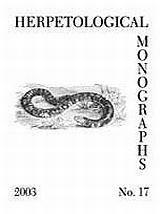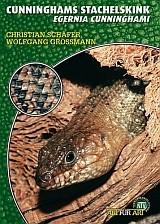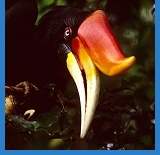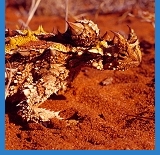




Related bibliographies:
Reptiles
 Lizards Lizards
 Scincidae Scincidae
Australia






































































































































































































































































































































| |

Bibliography of the genus
Egernia (Australian Greater Skinks)

(Reptilia: Sauria: Scincidae)
Note:
In order to limit redundancy, relevant literature indexed in the related bibliographies in the left column may not have been included in this page. For a comprehensive search of literature, these bibliographies should therefore also be consulted.
Egernia in general
 |
Adler, K.K. 1958. Observations on the Australian genera Egernia and Tiliqua in captivity. Trimon. Rep. Ohio herpet. Soc. 1(3): 9-12.
Bull, C.M.; Griffin, C.L.; Johnston, G.R. 1999. Olfactory discrimination in scat-piling lizards. Behavioral Ecology 10(2): 136-140.
Chapple, D.G. 2003. Ecology, life-history, and behavior in the Australian Scincid genus Egernia, with comments on the evolution of complex sociality in lizards. Herpetological Monographs 17: 145-180.
Chapple, D.G.; Keogh, J.S. 2004. Parallel adaptive radiations in and and temperate Australia: molecular phylogeography and systematics of the Egernia whitii (Lacertilia: Scincidae) species group. Biological Journal of the Linnean Society 83(2): 157-173.
Chapple, D.G.; Keogh, J.S.; Hutchinson, M.N. 2005. Substantial genetic substructuring in southeastern and alpine Australia revealed by molecular phylogeography of the Egernia whitii (Lacertilia: Scincidae) species group. Molecular Ecology 14(5): 1279-1292.
Cooper, T.; Vernes, K. 2011. Mycophagy in the larger bodied skinks of the genera Tiliqua and Egernia: are there implications for ecosystem health? Australian Zoologist 35(3): 681-684.
Donnellan, S.C. 1991. Chromosomes of Australian lygosomine skinks (Lacertilia: Scincidae). 1. The Egernia group: C-banding, silver staining, Hoechst 33258 condensation analysis. Genetica (Dordrecht) 83(3): 207-222.
Ehmann, H. 1983. The natural history and conservation status of the Adelaide pigmy bluetongue lizard Tiliqua adelaidensis. Herpetofauna (Sydney) 14(1-2): 61-76.
Fullagar, P.J. 1978. Seabird islands. Eclipse Island, Western Australia. Corella 2(2): 21-23.
Gardner, M.G.; Hugall, A.F.; Donnellan, S.C.; Hutchinson, M.N.; Foster, R. 2008. Molecular systematics of social skinks: phylogeny and taxonomy of the Egernia group (Reptilia: Scincidae). Zoological Journal of the Linnean Society 154(4): 781-794.
Glauert, L. 1960. Herpetological miscellanea. XII. The family Scincidae in Western Australia. Part. I. The genera Tiliqua, Trachysaurus and Egernia. Western Australian Naturalist 7: 67-77.
Gray, J.E. 1838. Catalogue of the slender-tongued saurians, with descriptions of many new genera and species. Annals and Magazine of Natural History (London) 2: 287-293.
Hollenshead, M.G. 2011. Geometric morphometric analysis of cranial variation in the Egernia depressa (Reptilia: Squamata: Scincidae) species complex. Records of the Western Australian Museum 26(2): 138-153.
Honda, M.; Ota, H.; Kobayashi, M.; Hikida, T. 1999. Phylogenetic relationships of Australian skinks of the Mabuya group (Reptilia: Scincidae) inferred from mitochondrial DNA sequences. Genes & Genetic Systems 74(4): 135-139.
Horton, D.R. 1972. Evolution in the genus Egernia (Lacertilia: Scincidae). Journal of Herpetology 6(2): 101-109.
Hutchinson, M.N. 1981. The systematic relationships of the genera Egernia and Tiliqua (Lacertilia: Scincidae). A review and immunological reassessment. pp. 176-193. In: Banks, C.B. & Martin, A.A. Proceedings of the Melbourne Herpetological Symposium May 19-21, 1980. Zoological Board of Victoria, The Royal Melbourne Zoological Gardens, Parkville, Victoria 3052. 199 pp.
Langkilde, T.; Shine, R. 2004. Competing for crevices: interspecific conflict influences retreat-site selection in montane lizards. Oecologia (Berlin) 140(4): 684-691.
Matz, G. 1972. Einige australische Skinke der Gattungen Egernia und Tiliqua. DATZ (Die Aquarien- und Terrarien-Zeitschrift) 25: 136-139.
Mitchell, F.J. 1950. The scincid genera Egernia and Tiliqua (Lacertilia). Records of the South Australian Museum 9(3): 275-308.
Schildger, B.J. 1987. Endoscopic sex determination in reptiles. pp. 369-375. In: Anonymous. Proceedings of the First International Conference on Zoological and Avian Medicine. Association of Avian Veterinarians & American Association of Zoo Veterinarians. 586 pp.
Schofield, J.A.; Gardner, M.G.; Fenner, A.L.; Michael, B.C. 2014. Promiscuous mating in the endangered Australian lizard Tiliqua adelaidensis: a potential windfall for its conservation. Conservation Genetics 15(1): 177-185.
Turner, G. 1997. The ingestion of sloughed skin by members of the genus Egernia (Scincidae). Herpetofauna (Sydney) 27(2): 35-38.
Welch, K.R.G. 1982. Herpetology of the Old World. 2. Preliminary comments on the classification of skinks (family Scincidae) with specific reference to those genera found in Africa, Europe and southwest Asia. Herptile 7(4): 25-27.
|
Egernia cunninghami
 |
Bartlett, R.D. 1981. Notes on Egernia cunninghami kreffti, an Australian skink. British Herpetological Society Bulletin 4: 36-37.
Barwick, R.E.; Bryant, C. 1966. Physiological and biochemical aspects of hibernation, in the scincid lizard, Egernia cunninghami. Physiological Zoology 39: 1-20.
Bustard, R. 1958. Larger Australian skinks. Water Life 13: 595-596.
Champion, J. 1994. The captive breeding and rearing of Cunningham's skink, Ergenia [Egernia] cunninghami, from Australia. Herptile 19(1): 13-16.
Champion, J. 1994. The captive care and breeding of Egernia cunninghami, Cunningham's skink. Rephiberary 194: 4-6.
Dinardo, J. 1984. A note on longevity in Egernia cunninghami with a new captive longevity record. Herpetofauna (Sydney) 15(1): 14-15.
Dyer, R.J.; Stow, A.J.; Sork, V.L.; Sunnucks, P.; Briscoe, D.A.; Gardner, M.G. 2001. The impact of habitat fragmentation on dispersal of Cunningham's Skink (Egernia cunninghami): Evidence from allelic and genotypic analyses of microsatellites. Molecular Ecology 10(4): 867-878.
Eifler, D. 2001. Natural history notes: Egernia cunninghami (Cunningham's Skink). Escape behavior. Herpetological Review 32(1): 40.
Fraser, S.P. 1985. Variability of heating and cooling rates during radiant heating in a scincid lizard, Egernia cunninghami. Comparative Biochemistry and Physiology A Comparative Physiology 80(3): 281-286.
Fricke, M. 2002. Egernia cunninghami (Gray, 1832) - Erfahrungen mit der Haltung und Nachzucht des Stachelskinks. Elaphe 10(4): 24-28.
Hart, H. 1978. Australische Immigranten: Stachelschwanzskinke. Pflege und Zucht von Egernia cunninghami. Aquarien Magazin 12(11): 534-536.
Honegger, R.E.; Schmidt, C.R. 1964. Herpetologisches aus dem Züricher Zoo. 1. Beiträge zur Haltung un Zucht verschiedener Reptilien. DATZ (Die Aquarien- und Terrarien-Zeitschrift) 17: 339-342.
Horton, D.R. 1972. Lizard scales and adaptation. Systematic Zoology 21(4): 441-443.
John, W. 1968. Zwei Australier: Amphibolurus barbatus und Egernia cunninghami. DATZ (Die Aquarien- und Terrarien-Zeitschrift) 21: 185-186.
Johnson, C.R. 1977. Thermoregulation in four Australian lizards of the genus Egernia (Sauria: Scincidae). Zoological Journal of the Linnean Society 60(4): 381-390.
Longley, G. 1947. Breeding Cunningham's skink (Egernia cunninghamii) in the vivarium. Proceedings of the Royal Zoological Society of New South Wales 1946-47: 30.
Munsch, W. 1981. Durch Nachzucht erhalten: der Stachelskink. Aquarien Magazin 15(6): 375-376.
Niekisch, M. 1975. Pflege und Nachzucht von Egernia cunninghami (Sauria, Scincidae). Salamandra 11(3-4): 130-135.
Niekisch, M. 1980. Terraristische Beobachtungen zur Biologie von Egernia cunninghami (Reptilia: Sauria: Scincidae). Salamandra 16(3): 162-176.
Ofori, B.Y.; Stow, A.J.; Baumgartner, J.B.; Beaumont, L.J. 2017. Combining dispersal, landscape connectivity and habitat suitability to assess climateinduced changes in the distribution of Cunningham's Skink, Egernia cunninghami. PLoS ONE 12(9): e0184193
Paton, J.B.; Paton, D.C. 1977. Seabird islands. West Island, South Australia. Corella 1(3): 65-67.
Peters, W.C.H. 1871. Über neue Eidechsen (Egernia krefftii, Euprepes (Riopa) punctatolineatus). Monatsberichte der Königlich Akademie der Wissenschaften zu Berlin 1871(February): 30-32.
Reardon, J. 1993. Captive care and propagation of Egernia cunninghami. ASRA (Association for the Study of Reptilia and Amphibia) Journal 1993: 5-11.
Schade, W. 1979. Egernia cunninghami Pflege und Zucht. Aquarium (Bornheim) 13(117): 132-133.
Schafer, C. 1999. Egernia cunninghami (Gray). Sauria (Berlin) 21(3): 471-474.
Schäfer, C.; Grossmann, W. 2006. Cunninghams Stachelskink - Egernia cunninghami. Natur und Tier-Verlag, Münster. 62 pp.
Schwaner, T.D.; Miller, B. 1984. Range extensions of reptiles in South Australia. Transactions of the Royal Society of South Africa 108(3-4): 215-216.
Stow, A.J.; Sunnucks, P. 2004. High mate and site fidelity in Cunningham's Skinks (Egernia cunninghami) in natural and fragmented habitat. Molecular Ecology 13(2): 419-430.
Stow, A.J.; Sunnucks, P. 2004. Inbreeding avoidance in Cunningham's Skinks (Egernia cunninghami) in natural and fragmented habitat. Molecular Ecology 13(2): 443-447.
Turner, G. 1997. The ingestion of sloughed skin by members of the genus Egernia (Scincidae). Herpetofauna (Sydney) 27(2): 35-38.
Wilson, K.J. 1974. The relationship of oxygen supply for activity to body temperature in four species of lizards. Copeia 1974(4): 920-934.
|
Egernia cygnitos
 |
Doughty, P.; Kealley, L.; Donnellan, S.C. 2011. Revision of the Pygmy Spiny-tailed Skinks (Egernia depressa species-group) from Western Australia, with descriptions of three new species. Records of the Western Australian Museum 26(2): 115-137.
|
Egernia depressa
 |
Bush, B. 1987. The movement of reptiles in mulga fenceposts with records from Esperance, Western Australia. Western Australian Naturalist 16(8): 171-172.
Chasen, F.N. 1925. On the introduction of an Australian Skink into Singapore Island. Journal Malayan Asiat. Soc. Singapore 3(1): 99-101.
Day, K. 1980. Notes on the birth of the pygmy spiny tailed skirk, Egernia depressa (Gunther) in captivity. Herpetofauna (Sydney) 11(2): 29.
Doughty, P.; Kealley, L.; Donnellan, S.C. 2011. Revision of the Pygmy Spiny-tailed Skinks (Egernia depressa species-group) from Western Australia, with descriptions of three new species. Records of the Western Australian Museum 26(2): 115-137.
Obelgoenner, L. 2009. Egernia depressa - ein stacheliges Juwel. Aquaristik Fachmagazin & Aquarium Heute 41(4)(208): 84-89.
Ortner, A. 1993. Nachzucht des Plattschwanz-Blauzungenskinkes. DATZ (Die Aquarien- und Terrarien-Zeitschrift) 46(1): 63.
Pianka, E.R. 2014. Notes on the ecology and natural history of two species of Egernia (Scincidae) in Western Australia. Western Australian Naturalist 29(3): 231-236.
Romer, J.D. 1955. An Australian skink, Egernia depressa (Gunther), introduced into Hong Kong. Mem. Hong Kong Biol. Circle 3: 5.
|
Egernia douglassi
 |
Glauert, L. 1956. A new skink from West Kimberley Egernia striolata douglasi ssp. nov. Western Australian Naturalist 5: 117-119.
|
Egernia eos
 |
Doody, J.S.; Cherriman, S.; Turpin, J. 2015. Natural history notes: Ctenophorus reticulatus (Western Netted Dragon), Ctenophorus caudicinctus (Ring-tailed Dragon), and Egernia eos (Central Pygmy Spiny-tailed Skink). predation. Herpetological Review 46(3): 433.
Doughty, P.; Kealley, L.; Donnellan, S.C. 2011. Revision of the Pygmy Spiny-tailed Skinks (Egernia depressa species-group) from Western Australia, with descriptions of three new species. Records of the Western Australian Museum 26(2): 115-137.
|
Egernia epsisolus
 |
Doughty, P.; Kealley, L.; Donnellan, S.C. 2011. Revision of the Pygmy Spiny-tailed Skinks (Egernia depressa species-group) from Western Australia, with descriptions of three new species. Records of the Western Australian Museum 26(2): 115-137.
|
Egernia formosa
 |
Bush, B. 1987. The movement of reptiles in mulga fenceposts with records from Esperance, Western Australia. Western Australian Naturalist 16(8): 171-172.
Pianka, E.R. 2014. Notes on the ecology and natural history of two species of Egernia (Scincidae) in Western Australia. Western Australian Naturalist 29(3): 231-236.
|
Egernia hosmeri
 |
Kinghorn, J.R. 1955. Herpetological notes. 5. 1. Taxonomic changes in the genus Rhynchoelaps. 4. A new species of Egernia from Queensland. Records of the Australian Museum 23(5): 283-286.
Morley, T.; Johnston, G. 2005. An albino Hosmer's skink, Egernia hosmeri. Herpetofauna (Sydney) 35(1): 62.
Peters, U.W. 1976. A hybrid birth a Taronga's reptile department. South Australian Naturalist 50(3): 53-54.
Post, M.J. 2000. The captive husbandry and reproduction of the Hosmer's skink Egernia hosmeri. Herpetofauna (Sydney) 30(2): 2-6.
Shea, G. 1995. Herbivory in Egernia hosmeri (Squamata: Scincidae). Herpetofauna (Sydney) 25(2): 8-11.
|
Egernia kingii
 |
Abbott, I. 1978. Seabird islands. Breaksea Island, King George Sound, Western Australia. Corella 2(2): 24-25.
Abbott, I. 1978. Seabird islands. Mistaken Island, King George Sound, Western Australia. Corella 2(2): 32-33.
Abbott, I. 1978. Seabird islands. Seal Island, King George Sound, Western Australia. Corella 2(2): 30-31.
Arena, P.C.; Wooller, R.D. 2003. The reproduction and diet of Egernia kingii (Reptilia: Scincidae) on Penguin Island, Western Australia. Australian Journal of Zoology 51(5): 495-504.
Dunlop, J.N.; Klomp, N.I.; Wooller, R.D. 1988. Seabird islands No. 188. Penguin Island, Shoalwater Bay, Western Australia. Corella 12(3): 93-99.
Hauschild, A.; Gassner, P. 1994. Zur Kenntnis von Egernia kingii: Morphologie, Ökologie, Terrarienhaltung und Zucht der Inselform von den Houtman Abrolhos/Westaustralien. Salamandra 30(3): 185-196.
Horton, D.R. 1972. Lizard scales and adaptation. Systematic Zoology 21(4): 441-443.
Johnstone, R.E.; Smith, L.A.; Klomp, N.I. 1990. Seabird islands. No. 204. Gulch Island, Archipelago of the Recherche, Western Australia. Corella 14(4): 133-134.
Johnstone, R.E.; Smith, L.A.; Klomp, N.I. 1990. Seabird islands. No. 205. Skink Island, Archipelago of the Recherche, Western Australia. Corella 14(4): 135-136.
Lane, J.A.K. 1978. Seabird islands, Saint Alouarn Island, Western Australia. Corella 2(2): 36-37.
Masters, C.; Shine, R. 2003. Sociality in lizards: Family structure in free-living King's Skinks Egernia kingii from southwestern Australia. Australian Zoologist 32(3): 377-380.
Meathrel, C.E.; Klomp, N.I. 1990. Predation of little penguin eggs by King's skinks on Penguin Island, Western Australia. Corella 14(4): 129-130.
Murphy, J.B. 2016. Art in Herpetology: Four historical views of a large Australian skink (Genus Egernia). Herpetological Review 47(4): 690-691.
Smith, L.A.; Johnstone, R.E. 1988. Seabird islands No. 187. Forrest Island, Archipelago of the Recherche, Western Australia. Corella 12(3): 91-92.
Wooller, R.D.; Dunlop, J.N. 1990. Predation of the eggs of silver gulls by reptiles. Corella 14(2): 62-63.
|
Egernia mcpheei
 |
Shea, G.M.; Sadlier, R.A.; Johnson, R. 2000. The scincid lizard Egernia mcpheei Wells & Wellington, 1984 in Queensland. Memoirs of the Queensland Museum 45(2): 266.
|
Egernia napoleonis
 |
Christie, K.; Craig, M.D.; Stokes, V.L.; Hobbs, R.J. 2011. Movement patterns by Egernia napoleonis following reintroduction into restored jarrah forest. Wildlife Research 38(6): 475-481.
Craig, M.D.; Benkovic, A.M.; Grigg, A.H.; Hardy, G.E.; Fleming, P.A.; Hobbs, R.J. 2011. How many mature microhabitats does a slow-recolonising reptile require? Implications for restoration of bauxite minesites in south-western Australia. Australian Journal of Zoology 59(1): 9-17.
Johnstone, R.E.; Smith, L.A. 1988. Ben Island, Archipelago of the Recherche, Western Australia. Corella 12(3): 89-90.
Johnstone, R.E.; Smith, L.A.; Klomp, N.I. 1990. Seabird islands. No. 203. Wickham Island, Archipelago of the Recherche, Western Australia. Corella 14(4): 131-132.
Johnstone, R.E.; Smith, L.A.; Klomp, N.I. 1990. Seabird islands. No. 204. Gulch Island, Archipelago of the Recherche, Western Australia. Corella 14(4): 133-134.
Johnstone, R.E.; Smith, L.A.; Klomp, N.I. 1990. Seabird islands. No. 205. Skink Island, Archipelago of the Recherche, Western Australia. Corella 14(4): 135-136.
Johnstone, R.E.; Smith, L.A.; Klomp, N.I. 1990. Seabird Islands. No. 206. Harlequin Island, Archipelago of the Recherche, Western Australia. Corella 14(4): 137-138.
Kimberley, C.; Craig, M.D.; Stokes, V.L.; Hobbs, R.J. 2012. Home range size and micro-habitat density requirements of Egernia napoleonis: implications for restored Jarrah Forest of South Western Australia. Restoration Ecology 20(6): 740-746.
Kimberley, C.; Stokes, V.L.; Craig, M.D.; Hobbs, R.J. 2013. Microhabitat preference of Egernia napoleonis in undisturbed jarrah forest, and availability and introduction of microhabitats to encourage colonization of restored forest. Restoration Ecology 21(6): 722-728.
Sandow, J.D.; Bailey, W.J. 1978. An experimental study of defensive stridulation in Mygalopsis ferruginea Redtenbacher (Orthoptera: Tettigoniidae). Animal Behaviour 26(4): 1004-1011.
Smith, L.A.; Johnstone, R.E. 1988. Seabird islands No. 187. Forrest Island, Archipelago of the Recherche, Western Australia. Corella 12(3): 91-92.
|
Egernia pilbarensis
 |
Storr, G.M. 1978. The genus Egernia (Lacertilia, Scincidae) in Western Australia. Records of the Western Australian Museum 6(2): 147-187.
|
Egernia richardi
 |
Peters, W.C.H. 1869. Über neue Saurier (Chaunolæmus multicarinatus, Tropidolepisma richardi und Gymnodactylus steudneri) und Batrachier (Cyclohamphus fasciatus und Hyla gracilenta). Monatsberichte der Königlich Akademie der Wissenschaften zu Berlin 1869(November): 786-790.
Schwaner, T.D.; Miller, B. 1984. Reptiles new to the fauna of South Australia. Transactions of the Royal Society of South Africa 108(3-4): 217-218.
Smith, H.M. 1939. A new Australian lizard, with a note on Hemiergis. Field Museum of Natural History Zoological Series 24: 11-14.
|
Egernia rugosa
 |
Bruton, M.J. 2013. Arboreality, excavation, and active foraging: novel observations of radiotracked woma pythons Aspidites ramsayi. Memoirs of the Queensland Museum 56(2): 313-329.
|
Egernia saxatilis
 |
Cogger, H.G. 1960. The ecology, morphology, distribution and specification of a new species and subspecies of the genus Egernia (Lacertilia-Scincidae). Records of the Australian Museum 25: 95-105.
Homan, P. 2006. New locality records for reptiles, including the vulnerable swamp skink Egernia coventryi, in South Gippsland, 2001 - 2005. Victorian Naturalist (Blackburn) 123(5): 335-338.
Horton, D.R. 1972. Lizard scales and adaptation. Systematic Zoology 21(4): 441-443.
Langkilde, T.; Lance, V.A.; Shine, R. 2005. Ecological consequences of agonistic interactions in lizards. Ecology (Washington, D.C.) 86(6): 1650-1659.
Langkilde, T.; O'Connor, D.; Shine, R. 2007. Benefits of parental care: do juvenile lizards obtain better-quality habitat by remaining with their parents? Austral Ecology 32(8): 950-954.
Langkilde, T.; Shine, R. 2005. How do water skinks avoid shelters already occupied by other lizards? Behaviour 142(2): 203-216.
Menkhorst, P.W. 1984. Use of nest boxes by forest vertebrates in Gippsland: acceptance, preference and demand. Australian Wildlife Research 11(2): 255-264.
O'Connor, D.; Shine, R. 2003. Lizards in 'nuclear families': a novel reptilian social system in Egernia saxatilis (Scincidae). Molecular Ecology 12(3): 743-752.
O'Connor, D.E. 2004. Natural history notes: Austrelaps superbus (Australian Copperhead) and Egernia saxatilis (Black Rock Skink). Predation. Herpetological Review 35(2): 174-175.
O'Connor, D.E.; Shine, R. 2004. Parental care protects against infanticide in the lizard Egernia saxatilis (Scincidae). Animal Behaviour 68(6): 1361-1369.
O'Connor, D.E.; Shine, R. 2006. Kin discrimination in the social lizard Egernia saxatilis (Scincidae). Behavioral Ecology 17(2): 206-211.
Shea, G.M.; Sadlier, R.A.; Johnson, R. 2000. The scincid lizard Egernia mcpheei Wells & Wellington, 1984 in Queensland. Memoirs of the Queensland Museum 45(2): 266.
Turner, G. 1997. The ingestion of sloughed skin by members of the genus Egernia (Scincidae). Herpetofauna (Sydney) 27(2): 35-38.
|
Egernia stokesii
 |
Arida, E.A.; Bull, C.M. 2008. Optimising the design of artificial refuges for the Australian skink, Egernia stokesii. Applied Herpetology 5(2): 161-172.
Bull, C.M.; Griffin, C.L.; Lanham, E.J.; Johnston, G.R. 2000. Recognition of pheromones from group members in a gregarious lizard, Egernia stokesii. Journal of Herpetology 34(1): 92-99.
Duffield, G.A.; Bull, C.M. 1996. Characteristics of the litter of the gidgee skink, Egernia stokesii. Wildlife Research 23(3): 337-342.
Duffield, G.A.; Bull, C.M. 1998. Seasonal and ontogenetic changes in the diet of the Australian skink Egernia stokesii. Herpetologica 54(3): 414-419.
Duffield, G.A.; Bull, C.M. 2002. Natural history notes: Egernia stokesii (Gidgee Skink). Opportunistic dispersal. Herpetological Review 33(3): 204-205.
Duffield, G.A.; Bull, C.M. 2002. Stable social aggregations in an Australian lizard, Egernia stokesii. Naturwissenschaften 89(9): 424-427.
Gardner, M.G.; Bull, C.M.; Cooper, S.J.B. 2002. High levels of genetic monogamy in the group-living Australian lizard Egernia stokesii. Molecular Ecology 11(9): 1787-1794.
Gardner, M.G.; Bull, C.M.; Cooper, S.J.B.; Duffield, G.A. 2001. Genetic evidence for a family structure in stable social aggregations of the Australian lizard Egernia stokesii. Molecular Ecology 10(1): 175-183.
Gardner, M.G.; Bull, C.M.; Fenner, A.; Murray, K.; Donnellan, S.C. 2007. Consistent social structure within aggregations of the Australian lizard, Egernia stokesii across seven disconnected rocky outcrops. Journal of Ethology 25(3): 263-270.
Gardner, M.G.; Godfrey, S.S.; Fenner, A.L.; Donnellan, S.C.; Bull, C.M. 2012. Fine-scale spatial structuring as an inbreeding avoidance mechanism in the social skink Egernia stokesii. Australian Journal of Zoology 60(4): 272-277.
Horton, D.R. 1972. Lizard scales and adaptation. Systematic Zoology 21(4): 441-443.
How, R.A.; Dell, J.; Robinson, D.J. 2003. The western Spiny-tailed Skink, Egernia stokesii badia: Declining distribution in a habitat specialist. Western Australian Naturalist 24(2): 138-146.
Knauf, S. 2006. Zur Haltung und Nachzucht des Australischen Stachelschwanzskinks, Egernia stokesii stokesii (Gray, 1845), mit Anmerkungen zum Fütterungs-management. 1. Reptilia (D) 11(60): 55-57.
Knauf, S. 2006. Zur Haltung und Nachzucht des Australischen Stachelschwanzskinks, Egernia stokesii stokesii (Gray, 1845), mit Anmerkungen zum Fütterungs-management. 2. Reptilia (D) 11(61): 78-83.
Knauf, S. 2007. Care and captive breeding of the Gidgee Skink Egernia stokesii stokesii. Reptilia (GB) 51: 61-69.
Koch-Isenburg, L. 1977. Egernia stokesi (Gray) - ein australischer Dornschwanzskink. Naturwissenschaftlicher Verein Darmstadt Bericht N.F. 1976(2): 9-11.
Lanham, E.J.; Bull, C.M. 2000. Maternal care and infanticide in the Australian skink, Egernia stokesii. Herpetological Review 31(3): 151-152.
Lanham, E.J.; Bull, C.M. 2004. Enhanced vigilance in groups in Egernia stokesii, a lizard with stable social aggregations. Journal of Zoology (London) 263(1): 95-99.
Main, A.R.; Bull, C.M. 1996. Mother-offspring recognition in two Australian lizards, Tiliqua rugosa and Egernia stokesii. Animal Behaviour 52(1): 193-200.
Mensforth, C.L.; Bull, C.M. 2008. Selection of artificial refuge structures in the Australian skink, Egernia stokesii. Pacific Conservation Biology 14(1-2): 63-68.
Pearson, S.K.; Godfrey, S.S.; Schwensow, N.; Bull, C.M.; Gardner, M.G. 2017. Genes and group membership predict Gidgee Skink (Egernia stokesii) reproductive pairs. Journal of Heredity 108(4): 369-378
Peters, U. 1972. Der Stachelskink. Aqua Terra 9(8): 81-82.
Peters, U.W. 1976. A hybrid birth a Taronga's reptile department. South Australian Naturalist 50(3): 53-54.
Popovskaya, S.P.; Astreiko, E.A. 2012. [Keeping and breeding of the Gidgee Skink, Egernia stokesii stokesii]. (In Russian). Nauchnye Issledovaniya v Zoologicheskikh Parkakh 28: 24-29.
Schroeder, M.; Macini, S. 2003. Die Haltung und Nachzucht des Stachelschwanzskinks Egernia stokesii stokesii (Gray, 1845). Sauria (Berlin) 25(4): 7-14.
Storr, G.M. 1978. The genus Egernia (Lacertilia, Scincidae) in Western Australia. Records of the Western Australian Museum 6(2): 147-187.
Zimmermann, H. 1979. Durch Nachzucht erhalten: Familie Stachelskink. Aquarien Magazin 13(7): 326-329.
|
Egernia striolata
 |
Bull, C.M.; Bonnett, M. 2004. Natural history notes: Egernia striolata (Tree Skink). Reproduction. Herpetological Review 35(4): 389.
Bull, C.M.; Griffin, C.L.; Bonnett, M.; Gardner, M.G.; Cooper, S.J.B. 2001. Discrimination between related and unrelated individuals in the Australian lizard Egernia striolata. Behavioral Ecology and Sociobiology 50(2): 173-179.
Bull, C.M.; Griffin, C.L.; Johnston, G.R. 1999. Olfactory discrimination in scat-piling lizards. Behavioral Ecology 10(2): 136-140.
Bustard, R. 1970. A population study of the scincid lizard Egernia striolata in northern New South Wales. 1 and 2. Proceedings Koninklijke Nederlandse Akademie van Wetenschappen (C) 73: 186-213.
Duckett, P.E.; Morgan, M.H.; Stow, A.J. 2012. Tree-dwelling populations of the skink Egernia striolata aggregate in groups of close kin. Copeia 2012(1): 130-134.
Henle, K. 1987. Population ecology and life history of lizards in an arid environment. pp. 187-190. In: van Gelder, J.J.; Strijbosch, H. & Bergers, P.J.M. (eds.). Proceedings of the 4th Ordinary General Meeting of the Societas Europaea Herpetologica. Societas Europaea Herpetologica, Faculty of Sciences, Nijmegen. 473 pp.
Matz, G. 1989. An axial duplication with double body in the lizard Egernia striolata (Peters). Herpetopathologia 1(1): 57-59.
Michael, D.R.; Cunningham, R.B.; Lindenmayer, D.B. 2010. Microhabitat relationships among five lizard species associated with granite outcrops in fragmented agricultural landscapes of south-eastern Australia. Austral Ecology 35(2): 215-226.
Michael, D.R.; Cunningham, R.B.; Lindenmayer, D.B. 2010. The social elite: habitat heterogeneity, complexity and quality in granite inselbergs influence patterns of aggregation in Egernia striolata (Lygosominae: Scincidae). Austral Ecology 35(8): 862-870.
Riley, J.L.; Noble, D.W.A.; Byrne, R.W.; Whiting, M.J. 2017. Does social environment influence learning ability in a family-living lizard. Animal Cognition 20(3): 449-458.
Simpson, K.N.G. 1973. Amphibians, reptiles and mammals of the Murray River region between Mildura and Renmark, Australia. Mitteilungen Naturhist. Mus. Hamburg 34: 275-279.
Smith, H.M. 1939. A new Australian lizard, with a note on Hemiergis. Field Museum of Natural History Zoological Series 24: 11-14.
Webb, M. 2013. Australian tree skinks Egernia striolata: care and breeding. Herptile 38(4): 113-118.
|
| | 
















































































































































































|

